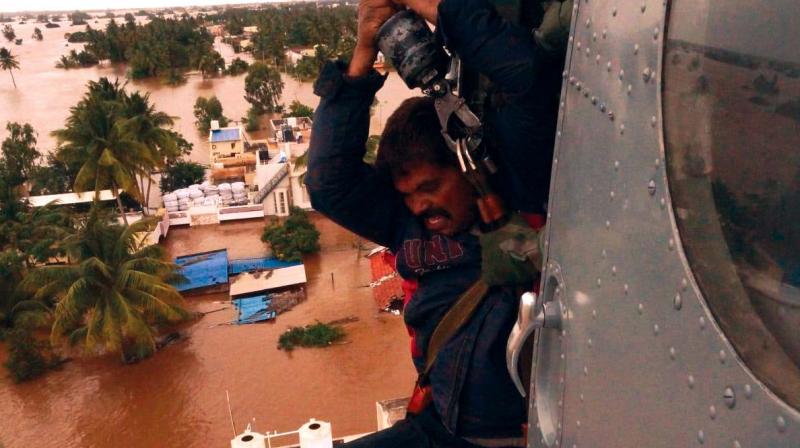IAF on rescue mission: They winched in to save flood-hit
In order to carry out the flood relief operations the MI 17 helicopter took off from Bengaluru and Belagavi was made the operations centre.

BENGALURU: One of the most arduous tasks the Indian Air Force (IAF) faces before reaching the site of flood relief operations is to negotiate poor visibility and overcast sky with rain and low clouds. In most flood relief operations especially in urban areas, the sole means of extricating the survivors is by winching them up while the helicopter is hovering.
“The next challenge is obtaining the exact locations of the survivors in an environment of limited or no communication. On reaching the site, the crew has to operate in close vicinity of natural and manmade obstructions such as tall trees, electric poles, mobile and microwave towers, building etc. There is also the additional risk of loose objects like tin shades, thatch roofs, water tank covers etc flying off due to the helicopter downwash and posing a threat to the safety of the helicopter,” explains Squadron Leader Dushyant Singh Rathore, who was commissioned in the flying branch of the IAF in 2009 and has been a flying instructor on MI 17 helicopter.
In order to carry out the flood relief operations the MI 17 helicopter took off from Bengaluru and Belagavi was made the operations centre.
The rescue operation has to be carried out with precision as the pilot has to battle strong and gusty winds with limited visual cues and yet hover rock steady for prolonged durations.
“Winching is not only taxing for the pilots, but is equally demanding for the survivors. Elderly people and children need assistance during this process so air warrior is first winched down from the helicopter to assist the survivors. He is usually the last to be winched up,” says the MI 17 pilot.
The stranded populace have been seen to employ innovative methods to attract the attention of the rescue helicopter. Bright bed sheets/saris, reflective mirrors, smoke indications and even SOS/SAVE marking on ground have been used.
The maintenance of the height of the helicopter depends on a number of variables like obstructions in the vicinity, effect of downwash from the helicopter rotors and length of the winch cable.
“Rescue missions demand the highest levels of skill and professionalism from the pilots. The IAF has very demanding and strenuous training and testing procedures which ensures that all helicopter pilots are equipped to undertaking such missions with the utmost safety,” Rathore says.
During the relief operations the pilots seldom take rest as the rescue mission are generally flown continuously from sunrise to sunset, with the crew stealing a few minutes rest while the helicopter is refuelled and loaded.
The number of sorties is dictated primarily by the distance of the affected area from the operating base.
Rathore finds it difficult to decide a particular mission that left an indelible mark on his mind as each mission he has been to were equally challenging but the satisfaction he gets after rescuing people swells his heart with pride.
“All the missions were equally challenging in their own way and at the end of the day, the sense of satisfaction which we get after rescuing people for whom you are the only hope is beyond words. The look of gratitude and love that I see in the faces of the people I have rescued is something that I will never forget,” he concludes.

